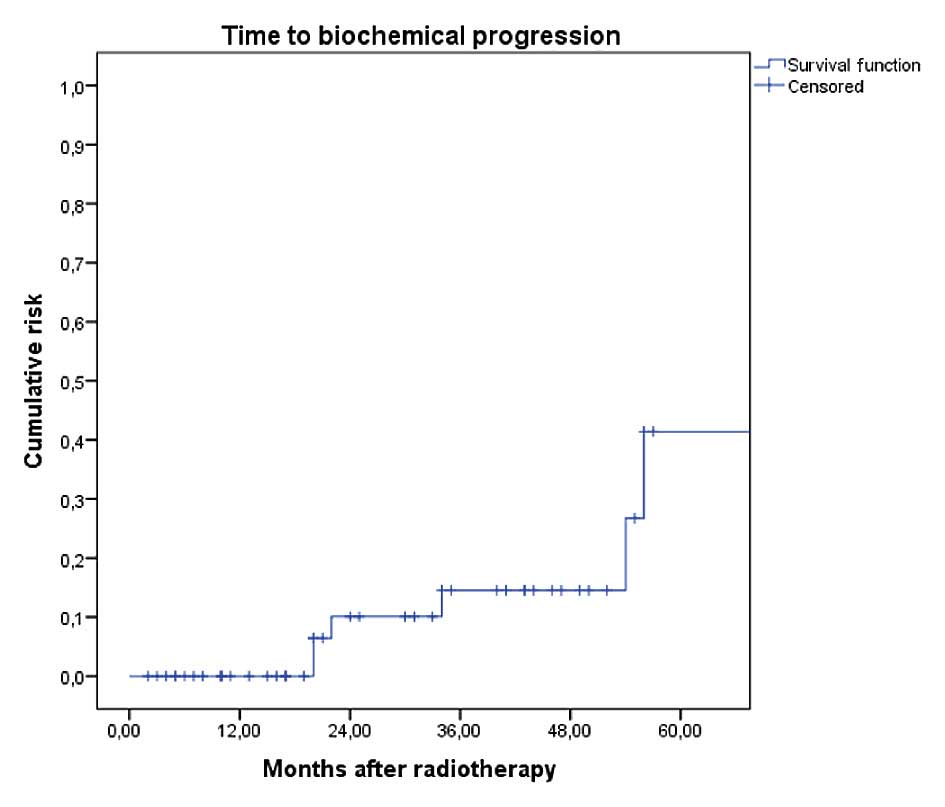|
1
|
De Meerleer G, Fonteyne V, Meersschout S,
et al: Salvage intensity-modulated radiotherapy for rising PSA
after radical prostatectomy. Radiother Oncol. 89:205–213. 2008.
View Article : Google Scholar : PubMed/NCBI
|
|
2
|
Bernard JR Jr, Buskirk SJ, Heckman MG, et
al: Salvage radiotherapy for rising prostate-specific antigen
levels after radical prostatectomy for prostate cancer:
dose-response analysis. Int J Radiat Oncol Biol Phys. 76:735–740.
2010. View Article : Google Scholar : PubMed/NCBI
|
|
3
|
Trock BJ, Han M, Freedland SJ, et al:
Prostate cancer-specific survival following salvage radiotherapy vs
observation in men with biochemical recurrence after radical
prostatectomy. JAMA. 299:2760–2769. 2008. View Article : Google Scholar : PubMed/NCBI
|
|
4
|
Jereczek-Fossa BA, Zerini D, Vavassori A,
et al: Sooner or later? Outcome analysis of 431 prostate cancer
patients treated with postoperative or salvage radiotherapy. Int J
Radiat Oncol Biol Phys. 74:115–125. 2009. View Article : Google Scholar : PubMed/NCBI
|
|
5
|
Valicenti RK, Thompson I Jr, Albertsen P,
et al: Adjuvant and salvage radiation therapy after prostatectomy:
American Society for Radiation Oncology/American Urological
Association guidelines. Int J Radiat Oncol Biol Phys. 86:822–888.
2013. View Article : Google Scholar : PubMed/NCBI
|
|
6
|
Shelan M, Abo-Madyan Y, Welzel G, et al:
Dose-escalated salvage radiotherapy after radical prostatectomy in
high risk prostate cancer patients without hormone therapy:
outcome, prognostic factors and late toxicity. Radiat Oncol.
8:2762013. View Article : Google Scholar : PubMed/NCBI
|
|
7
|
Stephenson AJ, Scardino PT, Kattan MW, et
al: Predicting the outcome of salvage radiation therapy for
recurrent prostate cancer after radical prostatectomy. J Clin
Oncol. 25:2035–2041. 2007. View Article : Google Scholar : PubMed/NCBI
|
|
8
|
Macdonald OK, D'Amico AV, Sadetsky N,
Shrieve DC and Carroll PR: Predicting PSA failure following salvage
radiotherapy for a rising PSA post-prostatectomy: from the CaPSURE
database. Urol Oncol. 26:271–275. 2008. View Article : Google Scholar : PubMed/NCBI
|
|
9
|
Moreira DM, Jayachandran J, Presti JC Jr,
et al: Validation of a nomogram to predict disease progression
following salvage radiotherapy after radical prostatectomy: results
from the SEARCH database. BJU Int. 104:1452–1456. 2009. View Article : Google Scholar : PubMed/NCBI
|
|
10
|
Lohm G, Lütcke J, Jamil B, et al: Salvage
radiotherapy in patients with prostate cancer and biochemical
relapse after radical prostatectomy: long-term follow-up of a
single-center survey. Strahlenther Onkol. 190:727–731. 2014.
View Article : Google Scholar : PubMed/NCBI
|
|
11
|
Geinitz H, Riegel MG, Thamm R, et al:
Outcome after conformal salvage radiotherapy in patients with
rising prostate-specific antigen levels after radical
prostatectomy. Int J Radiat Oncol Biol Phys. 82:1930–1937. 2012.
View Article : Google Scholar : PubMed/NCBI
|
|
12
|
Wiegel T, Lohm G, Bottke D, et al:
Achieving an undetectable PSA after radiotherapy for biochemical
progression after radical prostatectomy is an independent predictor
of biochemical outcome-results of a retrospective study. Int J
Radiat Oncol Biol Phys. 73:1009–1016. 2009. View Article : Google Scholar : PubMed/NCBI
|
|
13
|
Miyake M, Tanaka N, Asakawa I, et al:
Proposed salvage treatment strategy for biochemical failure after
radical prostatectomy in patients with prostate cancer: a
retrospective study. Radiat Oncol. 9:2082014. View Article : Google Scholar : PubMed/NCBI
|
|
14
|
Ceci F, Herrmann K, Castellucci P, et al:
Impact of (11) C-choline PET/CT on clinical decision making in
recurrent prostate cancer: results from a retrospective two-centre
trial. Eur J Nucl Med Mol Imaging. 41:2222–2231. 2014. View Article : Google Scholar : PubMed/NCBI
|
|
15
|
D'Angelillo RM, Sciuto R, Ramella S, et
al: 18F-choline positron emission tomography/computed
tomography-driven high-dose salvage radiation therapy in patients
with biochemical progression after radical prostatectomy:
feasibility study in 60 patients. Int J Radiat Oncol Biol Phys.
90:296–302. 2014. View Article : Google Scholar : PubMed/NCBI
|
|
16
|
Rischke HC, Schäfer AO, Nestle U, et al:
Detection of local recurrent prostate cancer after radical
prostatectomy in terms of salvage radiotherapy using dynamic
contrast enhanced-MRI without endorectal coil. Radiat Oncol.
7:1852012. View Article : Google Scholar : PubMed/NCBI
|
|
17
|
Beresford MJ, Gillatt D, Benson RJ and
Ajithkumar T: A systematic review of the role of imaging before
salvage radiotherapy for post-prostatectomy biochemical recurrence.
Clin Oncol (R Coll Radiol). 22:46–55. 2010. View Article : Google Scholar : PubMed/NCBI
|
|
18
|
Bolla M, van Poppel H, Collette L, et al:
Postoperative radiotherapy after radical prostatectomy: a
randomised controlled trial (EORTC trial 22911). Lancet.
366:572–578. 2005. View Article : Google Scholar : PubMed/NCBI
|
|
19
|
Thompson IM Jr, Tangen CM, Paradelo J, et
al: Adjuvant radiotherapy for pathologically advanced prostate
cancer: a randomized clinical trial. JAMA. 296:2329–2335. 2006.
View Article : Google Scholar : PubMed/NCBI
|
|
20
|
Wiegel T, Bottke D, Steiner U, et al:
Phase III postoperative adjuvant radiotherapy after radical
prostatectomy compared with radical prostatectomy alone in pT3
prostate cancer with postoperative undetectable prostate-specific
antigen: ARO 96-02/AUO AP 09/95. J Clin Oncol. 27:2924–2930. 2009.
View Article : Google Scholar : PubMed/NCBI
|
|
21
|
Choo R, Danjoux C, Gardner S, et al:
Efficacy of salvage radiotherapy plus 2-year androgen suppression
for postradical prostatectomy patients with PSA relapse. Int J
Radiat Oncol Biol Phys. 75:983–989. 2009. View Article : Google Scholar : PubMed/NCBI
|
|
22
|
Pai HH, Eldridge B, Bishop D, et al: Does
neoadjuvant hormone therapy improve outcome in prostate cancer
patients receiving radiotherapy after radical prostatectomy? Can J
Urol. 16:4541–4552. 2009.PubMed/NCBI
|
|
23
|
Leung CM, Li SC, Chen TW, et al:
Comprehensive microRNA profiling of prostate cancer cells after
ionizing radiation treatment. Oncol Rep. 31:1067–1078.
2014.PubMed/NCBI
|
|
24
|
Guttilla A, Bortolus R, Giannarini G, et
al: Multimodal treatment for high-risk prostate cancer with
high-dose intensity-modulated radiation therapy preceded or not by
radical prostatectomy, concurrent intensified-dose docetaxel and
long-term androgen deprivation therapy: results of a prospective
phase II trial. Radiat Oncol. 9:242014. View Article : Google Scholar : PubMed/NCBI
|
|
25
|
Grenader T, Plotkin Y, Gips M, Cherny N
and Gabizon A: Diethylstilbestrol for the treatment of patients
with castration-resistant prostate cancer, Retrospective analysis
of a single institution experience. Oncol Rep. 31:428–434.
2014.PubMed/NCBI
|
















